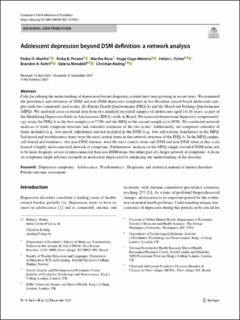| dc.contributor.author | Manfro, Pedro H. | |
| dc.contributor.author | Pereira, Rivka B. | |
| dc.contributor.author | Rosa, Martha | |
| dc.contributor.author | Cogo-Moreira, Hugo | |
| dc.contributor.author | Fisher, Helen L. | |
| dc.contributor.author | Kohrt, Brandon A. | |
| dc.contributor.author | Mondelli, Valeria | |
| dc.contributor.author | Kieling, Christian | |
| dc.date.accessioned | 2022-01-21T12:01:30Z | |
| dc.date.available | 2022-01-21T12:01:30Z | |
| dc.date.created | 2021-12-16T12:08:44Z | |
| dc.date.issued | 2021 | |
| dc.identifier.citation | European Child and Adolescent Psychiatry. 2021. | en_US |
| dc.identifier.issn | 1018-8827 | |
| dc.identifier.uri | https://hdl.handle.net/11250/2838687 | |
| dc.description.abstract | Calls for refning the understanding of depression beyond diagnostic criteria have been growing in recent years. We examined the prevalence and relevance of DSM and non-DSM depressive symptoms in two Brazilian school-based adolescent samples with two commonly used scales, the Patient Health Questionnaire (PHQ-A) and the Mood and Feelings Questionnaire (MFQ). We analyzed cross-sectional data from two similarly recruited samples of adolescents aged 14–16 years, as part of the Identifying Depression Early in Adolescence (IDEA) study in Brazil. We assessed dimensional depressive symptomatology using the PHQ-A in the frst sample (n=7720) and the MFQ in the second sample (n=1070). We conducted network analyses to study symptom structure and centrality estimates of the two scales. Additionally, we compared centrality of items included (e.g., low mood, anhedonia) and not included in the DSM (e.g., low self-esteem, loneliness) in the MFQ. Sad mood and worthlessness items were the most central items in the network structure of the PHQ-A. In the MFQ sample, self-hatred and loneliness, two non-DSM features, were the most central items and DSM and non-DSM items in this scale formed a highly interconnected network of symptoms. Furthermore, analysis of the MFQ sample revealed DSM items not to be more frequent, severe or interconnected than non-DSM items, but rather part of a larger network of symptoms. A focus on symptoms might advance research on adolescent depression by enhancing our understanding of the disorder. | en_US |
| dc.language.iso | eng | en_US |
| dc.publisher | Springer | en_US |
| dc.rights | Navngivelse 4.0 Internasjonal | * |
| dc.rights.uri | http://creativecommons.org/licenses/by/4.0/deed.no | * |
| dc.subject | depressive symptoms | en_US |
| dc.subject | adolescence | en_US |
| dc.subject | psychometrics | en_US |
| dc.subject | diagnostic and statistical manual of mental disorders | en_US |
| dc.subject | patient outcome assessment | en_US |
| dc.title | Adolescent depression beyond DSM definition: a network analysis | en_US |
| dc.type | Peer reviewed | en_US |
| dc.type | Journal article | en_US |
| dc.description.version | publishedVersion | en_US |
| dc.rights.holder | © The Author(s) 2021. | en_US |
| dc.subject.nsi | VDP::Medisinske Fag: 700::Klinisk medisinske fag: 750::Psykiatri, barnepsykiatri: 757 | en_US |
| dc.source.journal | European Child and Adolescent Psychiatry | en_US |
| dc.identifier.doi | 10.1007/s00787-021-01908-1 | |
| dc.identifier.cristin | 1969394 | |
| cristin.ispublished | true | |
| cristin.fulltext | original | |
| cristin.qualitycode | 2 | |

